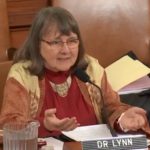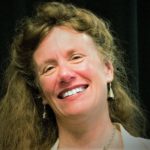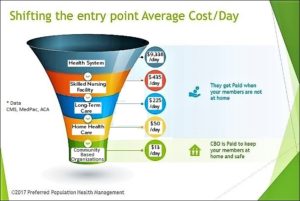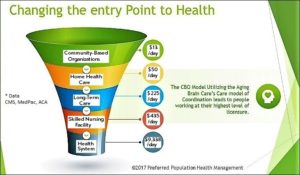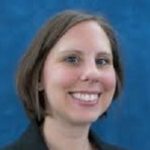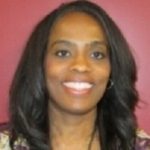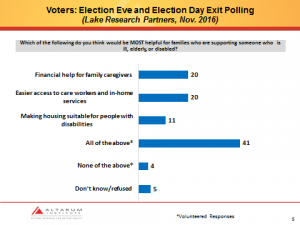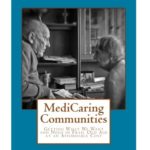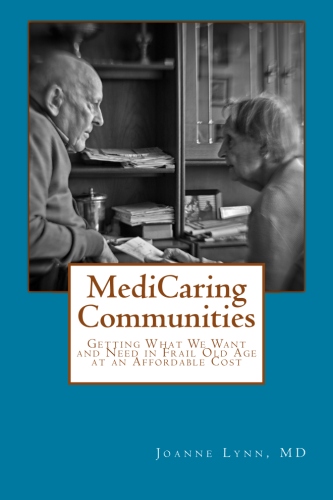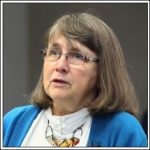
Dr. Joanne Lynn
by Joanne Lynn
Let’s try a thought experiment.
Imagine that the government assembled a “Medicare Design Commission” that includes not only the usual assorted experts, but at least as many 88-year old women living alone on Social Security in second floor walk-ups, aiming to have them represent the target population of elderly people coming to face the multiple challenges of disabilities, caregiving, and finances. What would emerge as the top priorities for an insurance plan? (Spoiler alert: It would look a lot different from the way Medicare looks today.)
Over the past few years, I’ve polled dozens of audiences on this question. Here are some of the most common rapid responses: dental care, eyeglasses, hearing aids, and podiatry. Accessible affordable housing, transportation, and nutrition services then come up, and many audiences branch out to other social supports — often respite care and help for family caregivers. Then there’s personal care, like help with bathing and with meals, and assistance with shopping and bills and cleaning. Sometimes medications are mentioned. Asked about hospital services, emergency care, and various medical procedures, many in the audiences seem perplexed. Yes, obviously, these need to be covered, but maybe they are not as highly prioritized by elderly people living with multiple chronic conditions and worsening disabilities. Sometimes someone calls out something like, “Save us from doctors!” Yet, Medicare covers those medical interventions and drugs, and none of the other things so readily listed.
When Medicare started, the average age at death was still under 70, and the usual causes were fairly abrupt – heart attacks, strokes, infections. Now, death comes, on average, nearly a decade later, and the usual experience of the last years of life is one of slow decline with substantial self-care disability. Nearly half of us will have cognitive failure in advanced old age[1]. Most people who live past age 65 will have two years or more of needing someone else’s help every day[2]; some will need that help for a decade or more. This is the major cause of personal bankruptcy now. This is the major exploding element in state budgets, as so many people need Medicaid for their long-term care expenses.
Yet, we have not generated a serious and creative discussion of how to support one another in old age. The current cohort of retirees does not generally have savings or insurance to cover their own costs, and the Boomer generation now coming to retirement is even worse, with few pensions, retirement savings lost in the 2008 recession and other stresses, and small and dispersed families unable to provide unpaid care. Older Americans Act funding has been stagnant for years [3], so waiting lists for food delivery are common, and many other supportive services are only occasionally available. Singapore in 1985 mandated that new buildings be adapted for disability living [4], so a person in a wheelchair there has housing options that elderly disabled Americans do not have.
Today, physicians can order up a drug or treatment regimen that costs $100,000. But they can’t order home-delivered meals, or suitable housing, or a hearing aid.
The fact is, Medicare needs some updating. And this invaluable bedrock social insurance program needs to be intelligently adapted and made more flexible so that it can work much more seamlessly with other programs that offer key services – like safe adapted housing and low-cost services that can be delivered at home. These are fundamental to keeping elders out of crisis and preventing elders from cycling repeatedly through costly care settings. The Senate has crafted a solid start – the CHRONIC Care Act (S. 870), which, with luck and some bipartisan cooperation, could be approved later this year. On the administrative front, a more flexible regulatory approach for the Program of All-Inclusive Care for the Elderly (PACE) could enable comprehensive and affordable care for disabled elders, including Medicare-only beneficiaries, who need both medical services and long-term care. Click to see our PACE analysis
The Center for Elder Care & Advanced Illness (CECAI) is calling for testing of a solid, evidence-informed model of care that would free communities to take an active role in monitoring and managing a good eldercare system: MediCaring Communities[5]. (Think “Villages” that are more ambitious and that are designed to take responsibility for all elders across a given area.) For a fast-growing population of elders living with worsening disabilities, the community where they live is their most important resource: It is where they find – or do not find — housing that is suitable for their limitations, home-delivered meals, subsidized accessible transportation, reliable personal care, appropriate medical care and support for family caregivers. Unlike many other countries, the U.S. doesn’t have a tradition yet of giving local communities a major role in ensuring the adequacy of eldercare services at a reasonable cost. The time has come to reconsider.
Multiple studies have already shown reduced use of hospitals and medical interventions from honest and comprehensive care planning, reliable around-the-clock support, and appropriate medical care[6]. If some of the savings from avoided costs on the medical services side of the ledger can be made available for services that communities need to buttress supportive services and the local care workforce, then we would be able to engineer more comprehensive reliable services for elders within current budget constraints[7]. Not only would this improve the lives of the elders and families in the communities that volunteered to try this out — they would provide a path for further reforms.
The partisan debates that are now absorbing most of the attention and running in a seemingly endless congressional loop are avoiding the challenges of long-term care for the rising population of frail and disabled elders that will double in the first half of this century. They ignore the fact that we have less than a decade to be ready for longevity on a mass scale.
So let’s change the channel and do some re-designing! When we’re 88, we’re going to need a different approach to health care – one that emphasizes living meaningfully and comfortably with the health challenges that must be endured, rather than pretending that prevention, cure, and rehabilitation are always available and effective. It’s time to try out much more fundamental changes in Medicare and Medicaid, along with private savings and voluntary caregiving. Living well in advanced old age requires buttressing essential programs such as the Older Americans Act [8], housing programs and workforce training. And having the elderly populations of cities and counties live well with the illnesses and disabilities that accompany their last years of life will require enabling communities to take a hand in measuring their systems’ performance and to manage improvements. In advanced old age, we will need not just medical care that Medicare now covers. We will also need supportive services such as nutritious food, safe housing, accessible transportation, caregiver support, hearing aids and dental care. Now that we know what we need, let’s illuminate the policy path and do the testing and evaluation work to make it possible for our future selves.
[1] Gardner RC, Valcour V, Yaffe K. Dementia in the oldest old: a multifactorial and growing public health issue. Alzheimers Research and Therapy 5 (4):27, 2013.
[2] Favreault M, Dey J. Long-term services and supports for older Americans: Risks and financing research brief. Unban Institute and Milliman. https://aspe.hhs.gov/pdf-report/long-term-services-and-supports-older-americans-risks-and-financing-research-brief (accessed September 24, 2017)
[3] Parikh RB, Montgomery A, Lynn J. The Older Americans Act at 50: Community-based care in a value-driven era. N Engl J Med 373 (5):399-401, 2015.
[4] Graham W C K., Bilger M. (2017), Financing Long-Term Services and Supports: Ideas from Singapore. The Milbank Quarterly, 95: 358–407. doi:10.1111/1468-0009.12264.
[5] Lynn J. MediCaring Communities: Getting what we want and need in frail old age at an affordable cost. Altarum Institute, 2016. https://medicaring.org/book-online/ (accessed September 24, 2017)
[6] Lynn J. MediCaring Communities, pp 57-66.
[7] Bernhardt A, Lynn J, Berger G, Lee J, Reuter K, DaVanzo J, Dobson A. Making it safe to grow old: A financial simulation model for launching MediCaring Communities for frail elderly Medicare beneficiaries. The Milbank Quarterly, 94: 597–625. 2016. doi:10.1111/1468-0009.12199.
[8] New LCAO briefs on OAA:
One-Pager: The Older Americans Act
Issue Brief: The Growing Role of the Aging Network in Improving Health Care and Reducing Costs
(accessed September 26, 2017)
